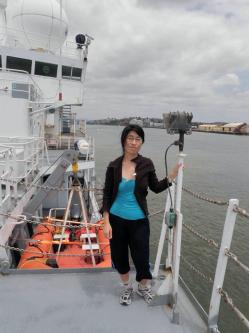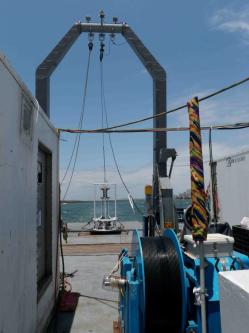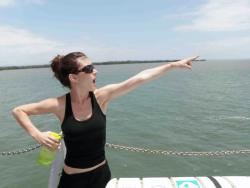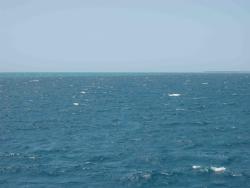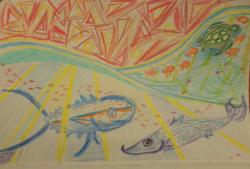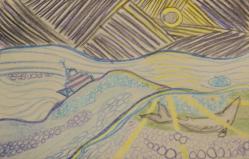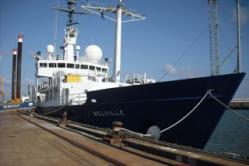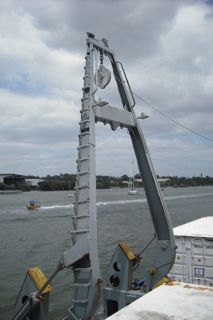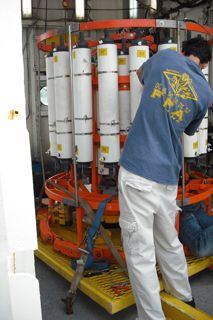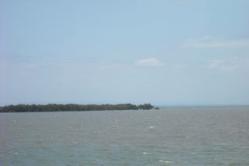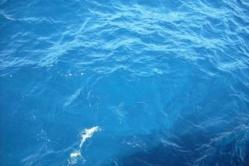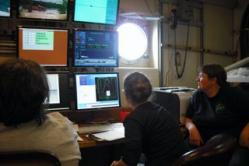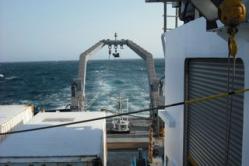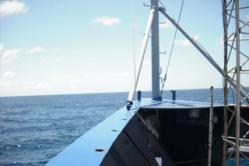Karen StamieszkinAt 10:00 in the morning, we departed from Forgacs Cairncross fitting out pier and the R/V Melville steamed on out toward the Pacific Ocean. On the way out, we passed the fringes of Brisbane’s suburbs and industrial lots; the water at the mouth of the river was muddy due to the sediment suspended by the incoming and outgoing tides. As we continued, the water turned blue and then green. Spirits aboard were generally high as we departed; the mad dash to get everything onboard and packed up was over. I finally learned about the duties of a CTD watch-stander! From a control desk, fitted with computer screens, the watch-stander communicates with the winch operator as the CTD is lowered, and then raised while the Niskin bottles are triggered to close. The Niskin bottles go down open, and when the rosette reaches the depth at which water is to be collected, a computer is told to trigger the bottle, and if it works, it closes capturing water from that particular depth. On this trip we will be collected water at depths from the sea-surface all the way down to over six kilometers! CTD stands for conductivity, temperature and depth. Conductivity tells us how much salt is the water, or what the salinity is. The winch operator is the person who lowers and retrieves the cable on which the CTD rosette is fixed. The watch-stander and winch operator work together, stopping the rosette at certain depths so that water can be collected there. When the rosette reaches the right depth, the watch-stander tells the winch operator to stop raising the rosette, and the niskin bottle(s) are triggered. Once the all the water is collected from the depths that the scientists want, the CTD is raised onto the deck and the watch-stander becomes a “water cop.” All the different science groups sampling for different things want some water, and there is only so much to go around. Therefore, a water cop makes sure that everyone goes in the right order, and that everyone gets the water they need. We will be doing a practice station around midnight tonight to make sure everything works. In the mean time, I have been reading and drawing. If you draw and want to contribute some pictures or poetry or art of any kind, depicting what you think it is like to be at sea, we would be happy to add your work to the Melville Nation Art Space. If you don’t have a scanner, but have a digital camera, you could make a drawing and then send a picture of it.
Karen StamieszkinMelville Nation Art Space
Mimi SzetoUpon arrival on the Melville, Liz was terribly sick so she was off to bed (see other journal entry). I went out to party with some members of the science team, all of whom were strangers still (except Jack, other UNH student), since I had just dropped my bags off on board and went back to downtown Brisbane. They all had the week to get to know each other (plus they had to load everything on to the ship). Lesson learned: try to arrive earlier. Nevertheless, I had a great time getting to know them on the dance floor at a jazz bar where Bill (science team) played the sax at a blues/jazz bar. (See pics in Karen's entry!) On the first day, I was inundated with unfamiliar terminology. Alison had a meeting with the CTD student watch standers, and we realized we were all clueless about our responsibilities. I thought we were going to measure conductivity, temperature, and depth, but apparently it is much more complicated! We actually handle the logistics of collecting seawater at certain depths, and distributing them to the different parties who process them for different types of measurements. This involves preparing the bottles of the rosette, helping the resident technician send the rosette on and off the ship, checking all the instruments while it is brought down to the bottom depth and up to the surface, tripping the bottles (closing them) at the desired depths on their way up, and making sure people go in order when they take water samples. Of course on our first tries, we were nervous and clumsy (or at least I was..I hope nobody posts that picture of me trying to cock that first bottle, I looked like I was attacking the thing and my hair was flying all over the place). After several repetitions, we've definitely gotten better at it despite all the mishaps at Station 3 (took us 6 times to get it!). Manning the console (tripping bottles and checking instruments) is a pretty big responsibility. The rosette is a 200,000-dollar piece of equipment (says Keith, resident technician). We want to try to get it down all the way to the bottom, but if we actually hit the bottom, we can damage the rosette or ruin the samples with silt. Sometimes there's electrical problems and of course, we have no idea how any of this stuff works. But that's why we have the res. techs running the show. It's slowly becoming less stressful for me. Seeing the real-time data is exciting too, because I just went over profiles of elemental and other oceanographic properties with my students from Introduction to Oceanography (I'm a TA). When we see them in the textbook or the lectures, it's difficult to consider all the work that goes into getting the data, and all the variables that could affect the results. And it's fun to point out things that I know of, like the oxygen minimum zone, which has occurred at just about 1000 to 1500 m around these parts (just north of New Zealand around 30 S 157 E). The OMZ has denitrifying bacteria that convert NO3 to N2 gas. Seeing everyone collect the water from the bottles once the rosette is brought up onto deck is exciting when you realize how expensive and exotic the water is. The first bottle is from the bottom of the ocean!! It may be 1600 years old! It's extremely cold compared to the last bottles from the surface. When this goes on, everyone is bumping into each other trying to quickly get water from the different bottles; it's pretty chaotic as there are probably at least 10 people who want samples from every bottle of the rosette. But I really enjoy this part, because it makes me appreciate the simple notion that we have capabilities to do such a thing and generate science out of it. I think my favorite thing so far is just having conversations with everyone, because these are the times when I learn the most. From Alison, the chief scientist, I learned how all the data is used (it's used as hydrography, which is input data, for models of ocean circulation), and how different institutions are funded and started. From the Mary, (ODF) and Rob (Res. Tech.), I've learned how all the equipment works. From Dave, I learned how the ship works and where everything is (generators and engines at the bow, connected by a shaft to the electric motors in the back, which start the propellers). From my conversations with the students and water sample processors, I was introduced to new professions I've never heard of, and started to imagine what it would be like to do be at sea all year round. From the trace metal guys (Chris Measures, Jack, Bill, and Max), I've learned how they measure Al and Rn from 1000 meters to the surface. Al is done by fluorometer with an indicator, and Rn by spectrophotometer.
Last updated: December 1, 2009 | |||||||||||||||||||||||||||
Copyright ©2007 Woods Hole Oceanographic Institution, All Rights Reserved, Privacy Policy. | |||||||||||||||||||||||||||
